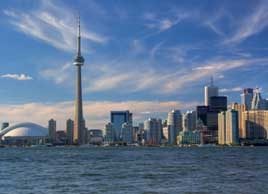Canada’s bluest communities: Toronto
The mayor of Toronto has pledged to make Canada’s largest city the most environmentally friendly on the continent, and that green dedication extends to its water

Source: Best Health Magazine, October 2008
Under a plan approved by city council in 2003, Toronto is investing more than $1 billion over 25 years to improve water quality along its waterfront and rivers.
About 25 percent of the city relies on antiquated sewers that carry storm water and waste in the same pipe. In heavy storms, the system is overloaded and the untreated water is routed into the Don and Humber rivers and Lake Ontario. Mary Trudeau, who co-authored a report on the urban water sector for the Federation of Canadian Municipalities, has seen aerial photographs from the year 2000 of the runoff after a storm. “They show a huge, brown plume hugging the shore where the Humber River empties into the lake.” So in the largest project of its kind in Canada, Toronto is building more than 175 storm-water ponds, underground tanks and tunnels, and more treatment facilities.
There’s also a massive project underway to clean up the Lower Don River and the inner harbour on Lake Ontario. Results are already evident, says the director of water infrastructure management for Toronto Water, Michael D’Andrea. He uses local beaches as a progress measure. When the city applied for Blue Flag status (an international designation for beach safety and cleanliness) in 2005, four of 11 beaches qualified; today there are six, and two more are close.
“There’s much still to be done,” says D’Andrea, “but we’re seizing all opportunities.”
Read more about Canada’s bluest communities:
• Chelsea, Que.
• Edmonton
• Halifax
• Okotoks, Alta.
Found this article informative? Subscribe to our magazine today and receive more Best Health exclusives delivered to your door!




